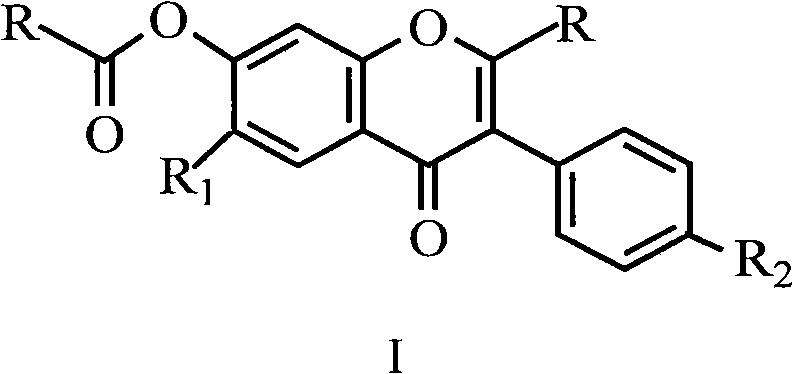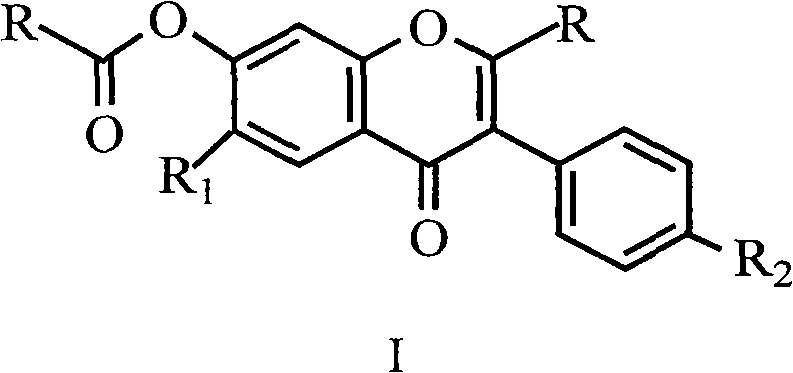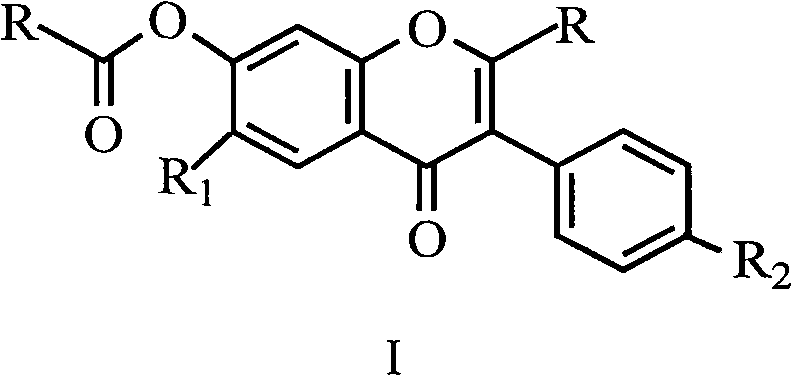Use of isoflavone with substituent at intermedium ring 2 position as animal feed additives
A technology of animal feed and isoflavones, applied in the direction of animal feed, animal feed, application, etc., to achieve the effect of eliminating antibiotic residues, improving economic returns, and high biological activity
- Summary
- Abstract
- Description
- Claims
- Application Information
AI Technical Summary
Benefits of technology
Problems solved by technology
Method used
Image
Examples
Embodiment 1
[0015] As a feed additive for piglets, it is a premix containing 10% of 6-methyl-2-ethyl-7-propionyloxy isoflavone, and its trade name is "new flavone". In the experiment, 108 [Du×(big×long)] weaned piglets with a body weight of about 7 kg were randomly divided into 3 groups, with 6 repetitions in each group, 6 piglets in each repetition (half male and half female), and the piglets in the three groups were fed with basic Diet (no new flavonoids added), basic diet +100mg / kg new flavonoids, basic diet +200mg / kg new flavonoids. The test results are as follows:
[0016] Effects of new flavonoids on growth performance of weaned piglets
[0017]
[0018] The results showed that adding new flavonoids to the diet increased the daily gain of weaned piglets and decreased the ratio of feed to weight gain. Compared with the basal diet group, the 100mg / kg and 200mg / kg newborn flavonoid groups increased the daily gain by 12.3% and 18.8% respectively (P<0.05), and the ratio of feed
Embodiment 2
[0020] As a feed additive for fattening pigs, it is a premix containing 10% of 6-methyl-2-ethyl-7-propionyloxyisoflavone, and its trade name is "new flavone". In the experiment, 240 three-component hybrid fattening pigs with a body weight of about 60kg [Du×(big×long)] (half barrows and half gilts) were selected and randomly divided into 4 groups, with 6 repetitions in each group and 10 pigs in each repetition. pig. The experimental design is as follows, 1) basal diet; 2) basal diet+150mg / kg neoflavonoids; 3) basal diet+300mg / kg neoflavonoids; 4) basal diet+125mg / kg 4% flavomycin. The test results are as follows:
[0021] Effects of new flavonoids on performance of finishing pigs
[0022]
[0023] The results showed that dietary supplementation of new flavonoids significantly increased the daily gain of finishing pigs and decreased the ratio of feed to weight gain. Compared with the basal diet group, the 150mg / kg and 300mg / kg newborn flavonoid groups increased the
Embodiment 3
[0025] As a feed additive for chickens, it contains 5% of 6-methyl-2-ethyl-7-propionyloxyisoflavone and 5% of 2,6,4'-trimethyl-7-acetoxyisoflavone Mixture, the trade name is "Xinhe flavonoids". In the experiment, 900 yellow-feathered broiler chicks (mixed seedlings) were randomly divided into 3 groups, with 6 repetitions in each group and 50 chickens in each repetition. The experimental design is as follows: (1) group is basal diet; (2) group is basal diet + Xinhe flavone 50 mg / kg; (3) group is basal diet + Xinhe flavonoid 100 mg / kg. The test results are as follows:
[0026] Effects of Xinhe flavonoids on performance of yellow-feathered broilers
[0027]
[0028] The results showed that dietary supplementation of new synthetic flavonoids significantly increased the weight gain of yellow-feathered broilers and decreased the ratio of feed to weight gain. Compared with the basic diet group, adding Xinhe flavonoids 50g / t and 100g / t at the chicken stage increased the wei
PUM
 Login to view more
Login to view more Abstract
Description
Claims
Application Information
 Login to view more
Login to view more - R&D Engineer
- R&D Manager
- IP Professional
- Industry Leading Data Capabilities
- Powerful AI technology
- Patent DNA Extraction
Browse by: Latest US Patents, China's latest patents, Technical Efficacy Thesaurus, Application Domain, Technology Topic.
© 2024 PatSnap. All rights reserved.Legal|Privacy policy|Modern Slavery Act Transparency Statement|Sitemap



